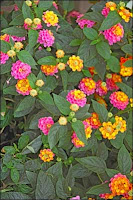Lantana camara
For those of us who love Lantana camara for its reliable summertime
flowers that bring butterflies and skippers to our gardens, it will come as a
bit of a surprise that the plant has many names and a bad reputation in some
places.
There is a creeping Lantana which is L. montevidensis. White
Flower Farm offers Lantana montevidensis Lavender Swirl that looks a lot like a
creeping Verbena. Lantanas are related to Verbena and the trailing verbenas are
also called Weeping or Trailing Lantana.
Lantana camara’s many names include: Shrub Verbena, Big Sage, Red, Yellow and Wild
Sage, Spanish Flag, West Indian Lantana, Lava, and Feston Rose.
 |
| Lantana Landmark Sunrise Rose |
They are considered cold hardy only to zone 9 but ours have
returned for 5 years, becoming larger every year. The plants have no known disease or insect
problems. They flower most when they are under-fertilized and under-watered.
They are also deer-resistant. If you
crush and smell a leaf, you will understand why deer avoid the plants.
Most Americans
grow Lantana camara as an ornamental but in other cultures it is grown as a
medicinal plant. The black berries that follow the flowers are poisonous if
eaten in large quantities.
In the U.S., pet
and livestock owners are warned to keep animals away from the berries but in
Surinam (Dutch Guiana) children eat the berries without harm.
Lantana leaves are used medicinally for itching skin, flu, cough, fever and
other ailments. The roots are used in the treatment of other diseases. An
extract of the leaves is anti-bacterial and used to cure ulcers and respiratory
infections in Brazil.
In FL, CA, TX, HI and other growing areas without a winter freeze, Lantana
camara is an invasive weed, coming up everywhere and becoming impossible to
eradicate.
 |
| Landmark Lantana Yellow |
There are 100 cultivated varieties. Here are some to
consider:
White flowers: Silver Mound, Clear White and Snowfall
Cream and gold flowers: Greg Grant
Pink to yellow flowers: Bronze and Lady Olivia
Pink yellow and ivory flowers: Patriot Honeylove is low
growing and spreads to form a ground cover. Luscious Tropical Fruit grows
2-feet tall and is recommended for zone 9.
Lavender: Pink Lace is upright with lavender and pink
flowers. Orchid is soft lavender that sprawls and cascades. Great for window
boxes, containers and wall gardens.
Yellow, orange and pink flowers: Confetti and Patriot
Rainbow
Gold flowers: Gold Mound and Patriot Moonshine. New Gold
grows 15-inches tall, spreads, flowers all summer, and is cold hardy to zone 7
 |
| Landmark Lantana Gold |
Multi-colors of yellow, red and pink: Irene and Spreading
Sunset
Butter yellow flowers: Lemon Drop and Yellow (sprawling, spreading
plants)
Orange, pink and coral flowers: Patriot Bouquet and
Patriot Desert Sun
Crimson red: New Red is an upright variety with
red-orange flowers. Bandana Cherry has fuscia red flowers and grows to 2-feet
tall.
Orange and yellow flowers: Miss Huff is 6-feet tall.
Variegated leaves: Samantha is a spreading plant with
lemon-lime leaves and bright yellow flowers.
Gold, deep orange and red flowers: Patriot Firewagon and
Radiation. Radiation is low-growing.
At the Proven Winners website there are photos of 24
varieties and you can look at the color combinations to see which ones would
work with your garden theme.
Lantanas are often grown as annuals and they are
available at nurseries and garden centers in the spring. They can also be grown
from 5-inch summer cuttings. Remove the flowers plus the lower leaves and plant
them in moist perlite.
Plant seeds this winter after soaking them for 24-hours.
Keep the soil temperature 75 degrees and seedlings will emerge in 40 to 60
days. Source: www.thompson-morgan.com.



Comments
Why are you digging them up? Do the previous summer's plants always die?
If so, I'll send you some cuttings of our most durable one. It grows in half shade on the edge of a lawn.
Thanks for the visit and kind words.
At woods' edge on the north part of the farm grows the old upright pink and yellow Lantana in company of pipevine and passiflora vines and beautyberry and other delights for butterflies that frequent the wild gardens.
The blog Coffee for Roses wrote about Lantana today, too.